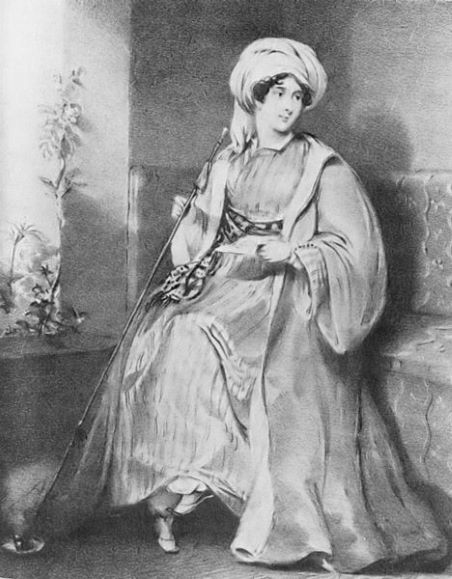
The previous post about Gertrude Bell asked for her link to Marylebone. The answer is she attended Queen’s College on Harley Street. Approximately 100 years earlier, there lived a woman with similar adventures in the Middle-East. This was Lady Hester Stanhope. (1776-1839).
In her late twenties Hester moved in with her uncle, William Pitt the Younger, at Walmer Castle in Kent where she redesigned the gardens. When William Pitt was re-appointed as Prime Minister in 1804, Hester moved with him into Downing Street where she played the role of social host to Pitt’s visitors and colleagues, and ran the household. Unusually for those times, Hester was nearly six-foot tall with a personality and presence to match, and she acquired high status amongst her uncle’s political friends.
William Pitt died in 1806 but not before he persuaded the government to grant Hester a generous pension for life.
Adjusting to a new life after Downing Street was probably challenging. She was no longer working at the heart of government. Rumours of a romance with Granville Leveson Gower were probably just rumours but she undoubtedly became very close to Sir John Moore, famed for his campaigns in the Peninsular War. His subsequent death at Corunna seems to have left Hester heart-broken and possibly depressed.
She decided to go travelling around the Mediterranean, accompanied by a couple of maids and her physician, Charles Meryon. In Gibraltar she met a much younger man, Michael Bruce, who became her lover and joined her entourage. Michael Bruce was a friend of Lord Byron who greeted Hester’s arrival in Athens by diving into the sea. Byron and Hester subsequently fell out, Byron describing her as ‘that dangerous thing, a female wit’. Perhaps she was simply the funnier of the two.
On the way to Egypt the party was shipwrecked. Hester lost all her possessions and clothes. She subsequently dressed in Turkish men’s attire: trousers, waistcoat and turban (later shaving her head so a turban fitted more snugly). She became legendary for her flouting of convention and her nerve. In Jerusalem, and Damascus she entered holy places on horseback without wearing a veil, both shocking breaches of protocol. She possessed a supreme self-confidence and convinced powerful, and often potentially violent, men that she was their equal. Her ride to Palmyra in 1813 was through territory dominated by a local Bedouin ruler whose reputation suggested he was more likely to stake her out in the boiling sun, but he was won over by her confidence and her amazing horse riding skills. On her entrance into Palmyra she was treated almost like a deity. She acquired mythical, almost divine, status amongst local communities.
A passionate archaeologist, her dig at Ashkelon was possibly the first properly researched and methodical dig in the Holy Land. She failed to find the sought-for millions of gold coins, but did find a massive headless Greco-Roman statue which Hester ordered to be smashed into a thousand pieces to prove she was not digging for treasures to take back to England. All a bit bizarre.
Hester eventually settled in a fortress on the top of a hill at Joun in the Lebanon and her home became the retreat for the persecuted in the area. Her perceived influence and power were such that local rulers were anxious not to make an enemy of her. There is a possibility she became unbalanced following a fever and it seems she started to believe in her divine mission, adopting a strange mule which would eventually carry her into Jerusalem as a Messiah. Her increasing eccentricity alienated the British government who stopped her pension and she fell heavily into debt, eventually living virtually as a hermit. Her servants started stealing from her, and at the age of 63 she finally died alone and unburied until the arrival of a British official who discovered her decomposing body. A sad end to a remarkable life.
The same question for Hester Stanhope as for Gertrude Bell: what is her link to Marylebone? (there are two links in fact). Would be great to receive your comments.

An amazing story. Thank you so much, David.
Pleased you enjoyed it